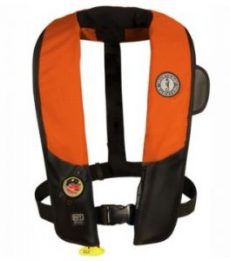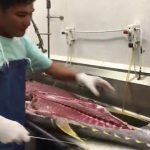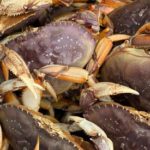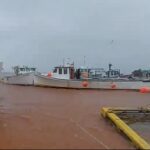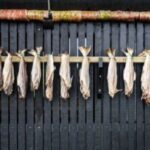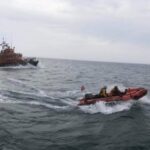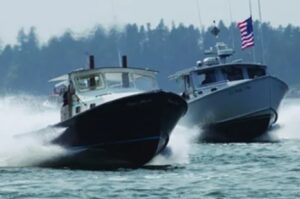Tag Archives: invasive green crab
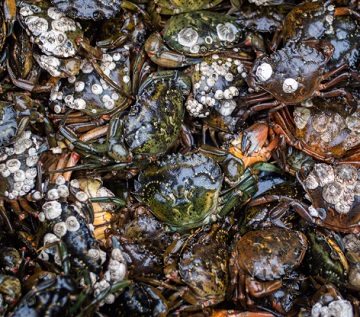
Crab ice cream, anyone? How we might be able to eat our way out of an invasive green crab problem
They’re tiny and they’re wreaking havoc on our coasts, but they also taste pretty good. European green crabs have posed a problem off the coast of Vancouver Island for decades now, and while current conservation efforts have focused on deep freezing them and throwing them in a landfill, some suggest eating them instead. The species, which is found across the Pacific Northwest is aggressive and feeds voraciously on shellfish; they have no natural predators, and they reproduce at a high rate. Each female can have up to 185,000 babies at a time. It’s not just a West Coast problem. Fisheries and Oceans Canada notes that the species, which originally came from Europe and North Africa and likely hitched a ride to North America on wooden ships in the early 19th century, first invaded east coast waters in the 1950s. >click to read< 09:50
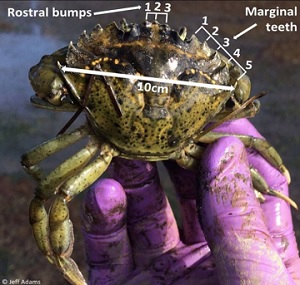
Invasive Green Crab Detected in Alaska for the First Time
The green crab is an invasive marine species spreading throughout the coastal waters of the United States. Efforts between NOAA Fisheries and Metlakatla Indian Community have been leading the way on monitoring to detect this species’ presence in Alaskan waters. The green crab has been found in U.S. waters since the 1800s, but this is the first confirmed presence in Alaska. They are a threat to native species and habitats. They are highly competitive predators that can decimate shellfish populations, outcompete native crabs, and reduce eelgrass and salt marsh habitats. They are a serious threat for Alaska’s tidal habitats. >click to read< 11:47
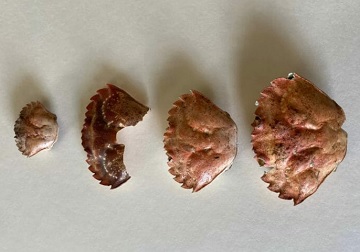
Evidence of invasive green crab that could wreak havoc on Alaska fisheries found near Metlakatla
An invasive species that could wreak havoc on commercial and subsistence fisheries has been found in Alaska for the first time. Biologists with Metlakatla Indian Community say they found the first evidence of European green crabs on Annette Island, near the southern tip of Southeast Alaska, in mid-July. NOAA Fisheries biologist Linda Shaw says they’re a particular threat to fellow shellfish. “They compete with juvenile Dungeness crab. They are shellfish predators, so things like clams, they would directly eat,” she said. “And then there’s also anecdotal information from British Columbia that they predate on juvenile salmon.” >click to read< 11:49

Crooks in a Crab Pot
Most people in the bays and estuaries of coastal South Jersey, including places such as Barnegat Bay, have concerns about someone stealing their crab pots or lifting the blue crabs in it. This applies to commercial fishermen as well as the recreational potters. What neither of these groups realizes is that there are probably thieves in their crab pots as well. And these thieves often go undetected even though they are stealing during the day and night and at all stages of the tide. These thieves are the ones that steal the bait from the crab pots. We learned about these thieves by placing a video camera in one of the mouths (tunnels) of a typical pot for blue crabs and dropping it into Willitt Creek with a feed that was attached to a monitor in my office. This approach allowed real-time observations and recording and also prevented me from getting a lot done when there was interesting behavior in the crab pot. click here to read the story 08:51
Declining worm harvest poses challenge for diggers, scientists
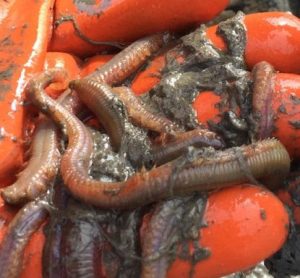 It’s a dirty job, but digging for blood and sand worms along the Maine coast can pay well, particularly in areas of the state where it can be hard to make a living. Maine’s annual harvest of these popular bait worms, however, continues to decline, posing a quandary for marine biologists who cite climate change and predation as possible factors. Wormers, as they’re called, would like to work with marine biologists to ensure a healthy and robust industry.,, Washington County worm diggers have their own theories. “You have biologists that come around, and I’m not taking away from people who go to school, but very few of them say, ‘Well, what do you guys think?’” says Fred Johnson of Steuben, president of the Down East chapter of the Independent Maine Marine Worm Harvesters Association. “They don’t see the changes in that inner benthic zone that we’ve seen over the years,” Bayrd says. Read the story here 14:27
It’s a dirty job, but digging for blood and sand worms along the Maine coast can pay well, particularly in areas of the state where it can be hard to make a living. Maine’s annual harvest of these popular bait worms, however, continues to decline, posing a quandary for marine biologists who cite climate change and predation as possible factors. Wormers, as they’re called, would like to work with marine biologists to ensure a healthy and robust industry.,, Washington County worm diggers have their own theories. “You have biologists that come around, and I’m not taking away from people who go to school, but very few of them say, ‘Well, what do you guys think?’” says Fred Johnson of Steuben, president of the Down East chapter of the Independent Maine Marine Worm Harvesters Association. “They don’t see the changes in that inner benthic zone that we’ve seen over the years,” Bayrd says. Read the story here 14:27
Invasive green crab population reaches record high in Shediac Bay
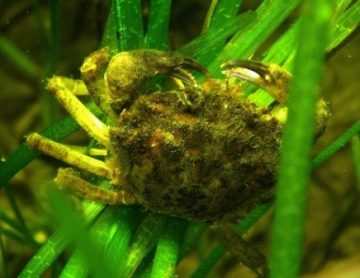 The population of green crabs in Shediac Bay has exploded this year, says Jim Weldon, of the Shediac Bay Watershed Association. Weldon, the green crab project manager, has been monitoring numbers of the aggressive invasive species since 2013. “This is the highest numbers we’ve ever seen,” he said. Weldon attributes the harsh winter of 2014 with keeping numbers at bay last year. “The ice was thick, the crabs that were hibernating in the mud were crushed, the numbers were way down.” The aggressive invasive crustacean can wreak havoc on eelgrass beds that provide shelter to other aquatic life. “They are going to go after the seed populations of mussels, oysters, quahogs and anything that is small enough that they can open.” Read the story here 12:59
The population of green crabs in Shediac Bay has exploded this year, says Jim Weldon, of the Shediac Bay Watershed Association. Weldon, the green crab project manager, has been monitoring numbers of the aggressive invasive species since 2013. “This is the highest numbers we’ve ever seen,” he said. Weldon attributes the harsh winter of 2014 with keeping numbers at bay last year. “The ice was thick, the crabs that were hibernating in the mud were crushed, the numbers were way down.” The aggressive invasive crustacean can wreak havoc on eelgrass beds that provide shelter to other aquatic life. “They are going to go after the seed populations of mussels, oysters, quahogs and anything that is small enough that they can open.” Read the story here 12:59
Lessons from ‘the last clam’: Casco Bay shellfish ‘renaissance’
 Tim Johnson of Harpswell had been clamming for more than 30 years when, in 2014, he hung up his hoe. Between predators such as the invasive green crab and other factors, the flats just weren’t profitable any more. “We’d go out, and there’s nothing there,” Johnson of Brunswick said. “It’s kind of depressing to dig the last clam.” In fact, the legal amount of softshell clams being harvested are down 70 percent since the green crab invasion of recent years, Brunswick Marine Resources Officer Dan Devereaux said — though he said the invasive crustaceans seem,,, Read the rest here 09:08
Tim Johnson of Harpswell had been clamming for more than 30 years when, in 2014, he hung up his hoe. Between predators such as the invasive green crab and other factors, the flats just weren’t profitable any more. “We’d go out, and there’s nothing there,” Johnson of Brunswick said. “It’s kind of depressing to dig the last clam.” In fact, the legal amount of softshell clams being harvested are down 70 percent since the green crab invasion of recent years, Brunswick Marine Resources Officer Dan Devereaux said — though he said the invasive crustaceans seem,,, Read the rest here 09:08

































